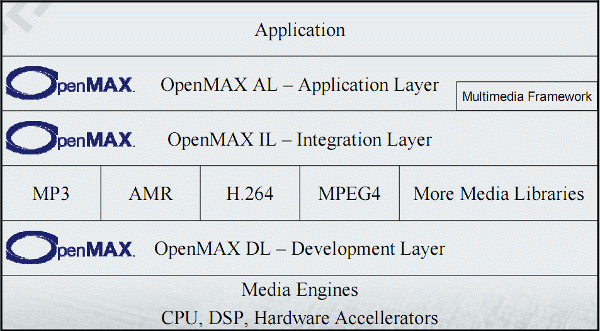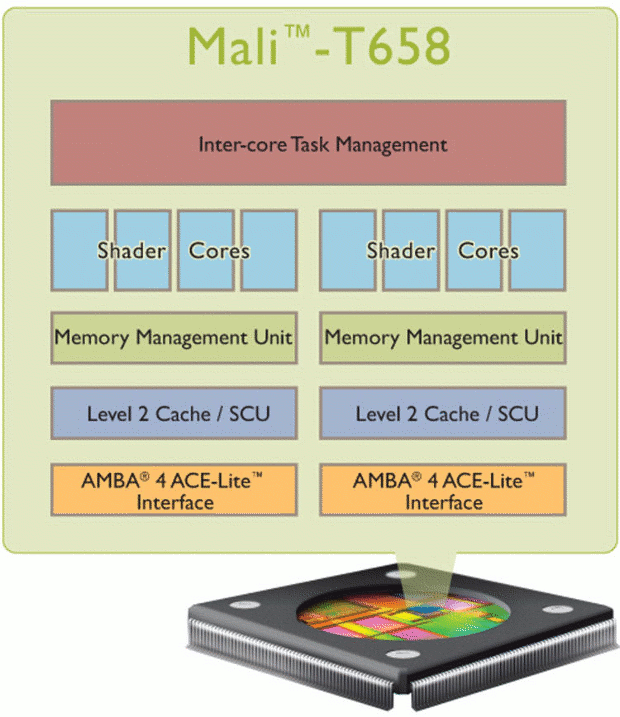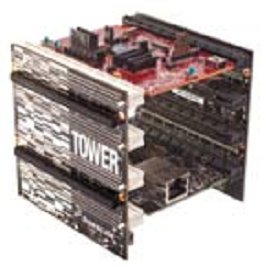OpenMAX (Open Media Acceleration) is a royalty-free, cross-platform set of C-language programming interfaces that provides abstractions for routines especially useful for audio, video, and still images. OpenMAX standard is managed by the non-profit technology consortium Khronos Group. OpenMAX allows developers to take advantages of hardware media decoding/encoding. For example, If you want to play video using Raspberry Pi hardware (VideoCore IV GPU in Broadcom BCM2835) you’ll have to use OpenMAX IL. OpenMAX provides three layers of interfaces: Application Layer (AL): Open standard for accelerating the capture, and presentation of audio, video, and images in multimedia applications on embedded and mobile devices. Integration Layer (IL) : API defining a standardized media component interface to enable developers and platform providers to integrate and communicate with multimedia codecs implemented in hardware or software. Development Layer (DL): APIs containing a comprehensive set of audio, video and imaging functions that can be implemented and optimized […]
ARM Announces New Mali-T658 GPU
About one year ago, ARM announced the Mali-T604 GPU which has yet to be used in current products. Yet today, ARM announced an even more powerful GPU called Mali-T658 in Tokyo at Japan ARM Technical Symposium. Mali T658 is based on Midgard GPU architecture (as is Mali T604) which allows great GPGPU capabilities thanks to three types of pipeline (‘tri-pipe’) optimized repetitively for arithmetic, load/store and texturing. The GPU will also support standard graphics APIs such as Khronos OpenGL ES, OpenVG andMicrosoft DirectX® 11) as well as Compute APIs such as Khronos OpenCL (Full Profile), Google RenderScript compute and Microsoft DirectCompute. Performance-wise, Mali-T658 has twice as many shader cores and double the arithmetic pipelines per core which means the GPU can offer up to 10 times the performance of the Mali-400 MP GPU. On the compute side, Mali-T658 provides 4 times the processing power of Mali-T604. Mali-T658 will work with […]
Brew Your Own Beer with Freescale Kinetis Cortex M4 MCU
This brewing system is part of top three designs for Freescale Make It Challenge: Kinetis MCUs. The two other designs are an Automobile Collision Detector and a “Swiss Army Knife” for the Blind . This design utilizes Freescale’s Kinetis K60 Tower System with MK64M512 Cortex M4 MCU and FreeRTOS operating system. This could become a beer brewing appliance with the target market being home brewers and small brewpubs and restaurants. Matthew Pratt (the one who design this system) says current hone brewing systems sell for about 10,000 USD. The sweet wort production process can be labor-intensive, requiring precise control of temperatures and transition times (It takes 4 to 5 hours for 5 gallons of beer). The Kinetis Beer Brewing System automates the process from the initial filling of water to the beer being ready to be cooled and yeast added. The user only needs to add the ingredients, malt and […]
Linaro’s Android Platform – ELCE 2011
Zach Pfeffer, Linaro Android Platform team leader, describes Linaro’s work on the Android platform and future plans at Embedded Linux Conference Europe 2011. Abstract: Linaro uses components from the Android Open Source Project, member companies, community supported efforts and Linaro engineering teams to build integrated, easy-to-use and well tested Android platforms for upstream work, product baselines and hobby projects. The team currently has platforms for TIs PandaBoard, BeagleBoard and Beagle xM, ST Ericsson’s Snowball, Samsung’s Origen and Freescale’s iMX53. They recently released platforms with Android 2.3.4 built against GCC 4.6 and running the 3.0 Linux kernel. In this session Zach reviews what’s been done, the Linaro Android concept, how Linaro brings Android together and what their plans are. Jean-Luc Aufranc (CNXSoft)Jean-Luc started CNX Software in 2010 as a part-time endeavor, before quitting his job as a software engineering manager, and starting to write daily news, and reviews full time later […]
Archos 80/101 G9 Firmware Version 3.2.69 Released
Archos has just released a new firmware for Archos 80 G9 / 101 G9. Here’s the changelog: Firmware changes Version 3.2.69 – November 9th, 2011 Web browser: faster web page rendering Media center: built in online subtitle download support after a long press on a video file under video browser Media scraper: faster information retrieval process External storage: add ability to mount disks without partition Android version: switch to Honeycomb 3.2.1 Battery: low charge notification Multimedia: support for split AC3, MPEG2 plugins The firmware can be downloaded at http://update.archos.com/9/gen9/gen9_3.2.69/firmware_archos_it4.aos Jean-Luc Aufranc (CNXSoft)Jean-Luc started CNX Software in 2010 as a part-time endeavor, before quitting his job as a software engineering manager, and starting to write daily news, and reviews full time later in 2011. www.cnx-software.com
Booting Userspace in Less Than 1 Second with Systemd – ELCE 2011
Koen Kooi, the lead developer of the Angstrom distribution, introduces systemd (sysvinit replacement) and shows how it can be integrated to a specific platform at Embedded Linux Conference Europe 2011. Abstract: Systemd is currently being hyped as *the* sysvinit replacement and this presentation will show why it’s here to stay. A brief introduction to systemd is given but the main focus is on showing how to integrate it into your favourite platform and how a few hours of tweaking can boot userspace into X11 in less than 1 second on the current generation of ARM chips (OMAP4 on Pandaboard). A comparison with slower low-end ARM chips is also be included and some design considerations when designing those low-end systems. The audience is system integrators and hobbyists that require a fast boot (e.g. robotics people). You can also download the presentation slides. Jean-Luc Aufranc (CNXSoft)Jean-Luc started CNX Software in 2010 as […]
ARM Linux Kernel Alignment & Benefits For Snowball – ELCE 2011
Andrea Gallo, Chief Linux Architect in the Smartphone and Tablet Solution organization in ST-Ericsson and part of the Linaro Technical Steering Committee, explains how a common Linux ARM kernel benefits ST Ericsson Snowball development platform. Abstract: Last March, the ARM Linux community got shaken by the complaints by Linus Torvalds for its lack of proper structure and organization. This is totally true and mainly due to the large number of different SoC vendors, each one integrating the ARM IP’s in a slightly different variant. Linaro immediately accepted the challenge to drive the kernel alignment of the ARM community and most ARM Linux experts got together and agreed on the way forward as early as May 2011 at the Developers’ summit in Budapest. ST-Ericsson is a founding member of Linaro and some key ST-Ericsson engineers are assigned to Linaro and specifically to this kernel alignment working force. In the speech, Andrea […]
Embedded Linux Optimization Techniques – ELCE 2011
Benjamin Zores, Alcatel-Lucent, describes different optimization techniques (focusing on hardware choice and software architecture) that can be used to improve the performance of embedded linux at Embedded Linux Conference Europe 2011. Abstract: This presentation provides a series of techniques that can be used for Linux embedded systems fine-grain tuning and performances optimization. Embedded systems are, by definition, always limited in terms of resources while people keep on trying to use desktop-oriented software on top of it. This talk presents a series of tips that can be used to actually measure, find and isolate bottlenecks in your system, whether it is by complete system profiling or software architecture optimization. Focus is also made on the traditional caveats that need to be avoided for your system not to be slow by design. You can also download the presentation slides. Jean-Luc Aufranc (CNXSoft)Jean-Luc started CNX Software in 2010 as a part-time endeavor, before […]






